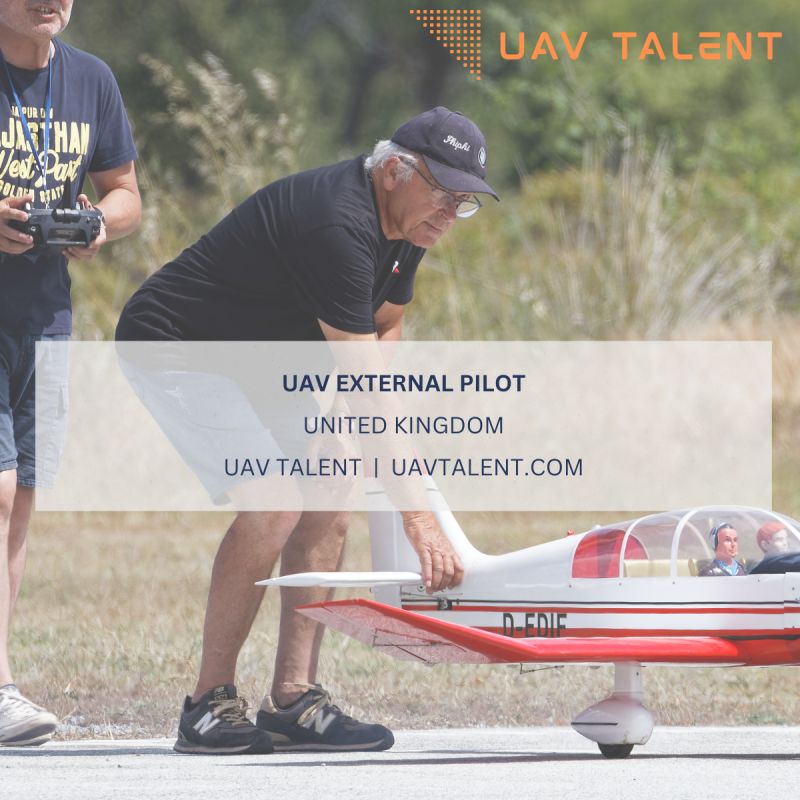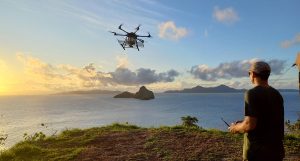UAV External Pilot: The Ultimate Guide for Aspiring and Professional Remote Pilots in the UK
Imagine standing on a misty English hillside, radio controller in hand, eyes fixed on the horizon. Somewhere above, your unmanned aerial vehicle (UAV) soars through the air, its sensors mapping ancient ruins or scanning crop fields. Below, a sheep gazes with mild interest—while you, an external pilot, create a synergy of technology, regulation, and traditional aviation skills. Welcome to the dynamic realm of UAV external pilots in the United Kingdom.
This guide will elucidate the role of a UAV external pilot in 2025, whether you’re interested in cinematic drone shots, industrial inspections, or understanding the evolving regulations and opportunities.
Who Is an ‘External Pilot’? The Role and Its Evolution
The term UAV external pilot describes someone who operates and monitors an unmanned aircraft from a distance using a ground control station, radio controller, or specialized interface. You might hear terms like remote pilot or drone operator, but ‘external pilot’ is becoming more prevalent in official and international contexts.
Key Responsibilities:
- Maintaining constant situational awareness and control (or oversight) of the UAV.
- Ensuring safe operation according to airspace regulations and mission requirements.
- Responding swiftly to safety issues or airspace instructions from authorities.
An RPA is an aircraft piloted by a licensed ‘remote pilot’ situated at a ‘remote pilot station’ located external to the aircraft (i.e., ground, ship, another aircraft, space), who monitors the aircraft continually and can react to instructions from ATC.
‘UAV’ vs. ‘Drone’ vs. ‘UAS’: Clearing Up the Jargon
- UAV (Unmanned Aerial Vehicle): The airborne machine itself—no crew on board.
- UAS (Unmanned Aircraft System): The full ecosystem: UAV, control station, communications, software, and pilot.
- Drone: A popular, encompassing term; often used interchangeably, but ‘UAV’ is preferred in professional and military scenarios.
As an external pilot, you’re the human factor in a complex UAS, directing the UAV from the ground.
What’s It Like to Be a UAV External Pilot Today?
A Day in the Life
Your morning might begin with checking flight plans on a laptop, inspecting batteries and payloads (such as cameras or LiDAR), and reviewing weather forecasts. During operations, your fingers control joysticks and screens; your eyes shift between the UAV in the sky and live video feeds. Whether flying a mapping mission over a quarry or filming a new housing project’s promotional video, your technical skills and regulatory awareness ensure safety.
Skills and Mindset
- Technical acumen: From radio frequencies to firmware updates, continuous learning is key.
- Problem-solving: What if the GPS fails? What if a gull becomes too inquisitive? You’re prepared with plan B (and C).
- Calm under pressure: When unexpected events occur, you maintain composure.
- Regulatory savvy: You are well-versed in UK Dronecode and stay updated.
Real-World Example
James, a UAV external pilot in Yorkshire, operates a drone-based inspection company. “One day, I’m inspecting wind turbines in strong winds, the next, teaching kids about aviation at a STEM fair. The tech is impressive, sure, but it’s the people—clients, bystanders, even the local farmer’s dog—that make each flight memorable.”
Regulations and Certification: The UK Landscape in 2025
The UK boasts one of the most advanced drone regulatory frameworks worldwide, balancing innovation and public safety. Here’s what external pilots need to know:
Legal Requirements
For UAVs from 250g to 25kg:
- Registration and Test: Mandatory registration with the Civil Aviation Authority (CAA); obtain both Operator ID and Flyer ID by passing an online theory test.
- Operator ID: Displayed on all UAVs during operation.
- Flyer ID: Valid for three years (renewable), Operator ID for one year.
- Minimum Age: Under 18s can only be registered as flyers—not operators—by a parent or guardian.
Operational Rules (UK Dronecode):
- Never fly above 400 feet (120 m).
- Always keep your drone in sight (Visual Line of Sight—VLOS).
- Stay 150 feet (46 m) from individuals, 500 feet (150 m) from crowds/structures.
- No flying near airports or airfields.
- No flights over uninvolved people or urban areas without special permissions.
Commercial Operations and the GVC
For work outside the “Open category” rules (e.g., closer to people or in urban environments), you’ll need an Operational Authorisation from the CAA.
- This typically involves a GVC (General VLOS Certificate):
- Ground school and practical assessment.
- Permission for urban and specialized work.
Foreign Operators: Must apply for permission with the UK CAA; foreign licenses aren’t automatically accepted.
Recent Changes and Future Trends
- Remote ID: Required for many UAVs, allowing real-time tracking by authorities.
- Flyer ID for sub-250g drones: Even small drones need basic registration and training.
- Continuous updates: The UK aims to keep regulations adaptive as technology evolves.
The Tech Behind the Role: Tools of the External Pilot
Today’s UAVs range from compact quadcopters to sizeable, fixed-wing aircraft for industrial purposes.
Key System Components
- UAV/Drone: The airframe, motors, propellers, primary onboard computers, and sensors.
- Ground Control Station: Ranging from simple handheld controllers to sophisticated mobile command centers with multiple screens, data links, and backup communications.
- Payloads: Includes cameras (RGB, infrared, multispectral), LiDAR, sampling tools, and delivery pods.
- Software: Encompasses autopilot firmware, mission planning applications, flight loggers, and real-time data transmission software.
Typical Missions
- Aerial Photography & Videography: From weddings to news broadcasts.
- Land Surveying/Mapping: Applications in agriculture, construction, environmental monitoring.
- Industrial Inspection: Power lines, wind turbines, oil rigs—especially when conventional methods aren’t feasible.
- Public Safety: Search & rescue, disaster assessment, police surveillance.
- Logistics & Delivery: Delivering parcels to challenging locations.
- Research: Wildlife tracking, atmospheric sampling.
Human Side: Why People Love (and Trust) UAV External Pilots
Meet the Team
Behind every successful drone operation is a team passionate about aviation and technology. Our team at DroneLogic UK includes:
- Gareth, ex-RAF pilot and your drone mentor.
- Sasha from IT, the mission planning genius.
- Tariq, ensuring all batteries are safe and ready.
We don’t just fly drones. We listen. We understand your needs—be it for a wedding, a crucial inspection, or a conservation project. Our motto? Trust built at 120 meters.
Success Stories
- Urban Rescue: Our rapid UAV deployment helped Manchester police locate a missing hiker in fog-covered moors.
- Historic Preservation: Collaborating with English Heritage, we mapped castles using sub-2kg UAVs without harming fragile sites.
- Agriculture: For a Yorkshire vineyard, we delivered detailed maps, spotting pest infestations weeks before visible damage.
Client Tip: “We learned more about our land in one afternoon with Sasha and her survey drone than ever before,” shares Tom, a farm owner near Bath.
Top Mistakes New External Pilots Make (And How to Avoid Them)
- Ignoring the Weather: UK conditions change rapidly—check the weather before and during each flight.
- Losing Visual Contact: VLOS is both a legal and safety necessity. “Just over the hedge” might cost you your drone and your reputation.
- Not Updating Firmware: Like all technology, keep your flying software current—security and flight errors are real risks.
- Forgetting Insurance: Accidents can happen, even to the best. Don’t endanger your livelihood (or your client’s property).
- Skipping Records: Always maintain meticulous flight logs—to prove your professionalism and for CAA compliance.
Pro Tips for Aspiring UAV External Pilots
- Invest in Training: Even for recreational flying, a certified course is beneficial. The GVC grants numerous opportunities.
- Know Your Airspace: Apps like NATS Drone Assist and UAV Forecast are vital.
- Practice Emergency Procedures: Autoresume and return-to-home drills should become instinctive.
- Network: Join local drone clubs or online forums. The UK UAV community is ever-evolving and welcoming.
- Stay Curious: The best pilots are perpetual learners. Cloud types, RF interference, photogrammetry—each detail enriches your flying legacy.
“To master the drone is to master the air, the rules, and your own sense of wonder.”
The Future Is Bright (and Autonomous, and Regulated)
With innovations in AI, automation, and sensor integration, UAV external pilots will supervise more autonomous missions in the future, although the human aspect will remain vital. The UK’s approach to flexible, consultative regulation fosters innovation and public confidence. Expect more opportunities, from drone deliveries in remote areas to cinematic shots for films set on the Thames.
For those passionate about aviation, technology, and steady hands, there’s never been a more exciting time to be a UAV external pilot.
Final Note
If you’re looking to buy a drone, acquire the best drone for photography, or learn the requirements for a drone license, our team stands ready to assist—whether you’re a beginner, entrepreneur, or experienced pilot seeking new horizons. We’re not just operators; we’re your partners in the sky.
And when uncertain… always check for curious sheep before takeoff.
*Written with appreciation for all external pilots shaping the future of the UK’s drones. Reach out with your questions, dreams, and flying stories—the sky truly is the limit!*













